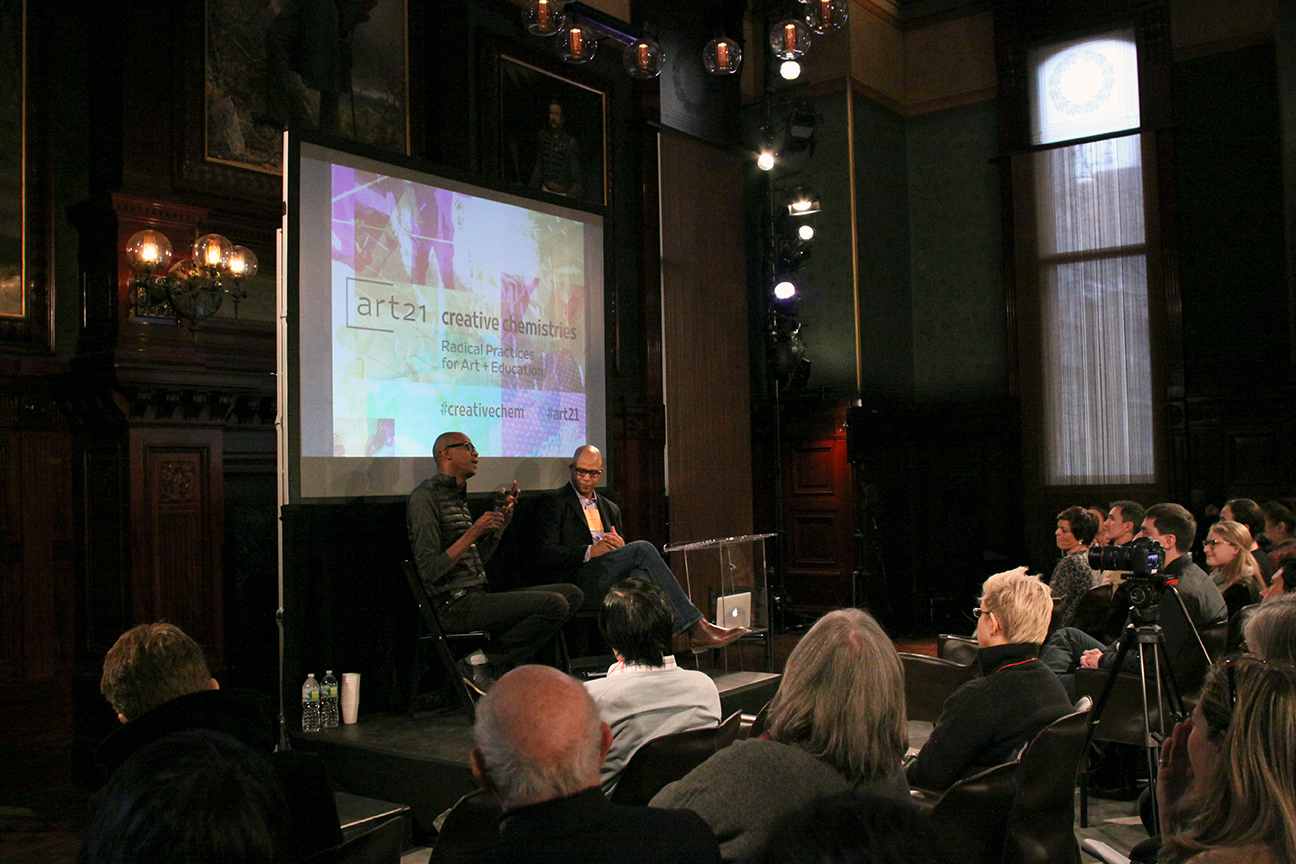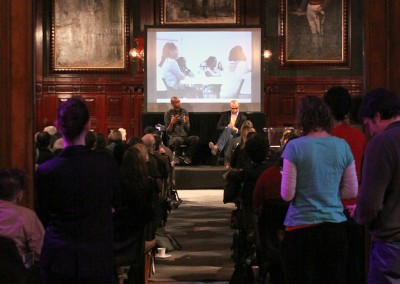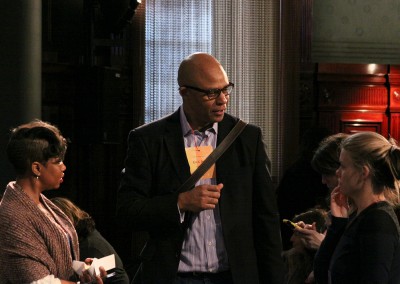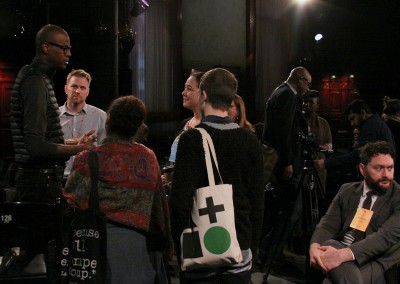Art + Education: Advocating for a New Paradigm
Exchange, Part 1
In this first exchange, Eric Pryor and Mark Bradford sat down to discuss their work and ideas around advocacy in art and education for all students. Despite substantial societal and financial challenges, both have kept their idealism in tact and strive toward equity for those students traditionally considered underserved. By tackling the problem from different contexts, both are working towards a paradigm shift in art education, expanding the possibilities for school and community-based programs.
When this exchange took place, Eric Pryor was the Executive Director for The Center for Arts Education, a New York City nonprofit bringing art inside the classroom through school and community programs, professional development, parent engagement and advocacy.
The following summer he became the President for Harlem School of the Arts, which serves nearly 4,000 students every year at its Herb Alpert Center in Harlem and throughout New York City with arts education programs in public and charter schools and community centers.
Eric Pryor – “The Center for Arts Education was founded in 1996. Our mission is to ensure that all New York City public school students have a quality education that includes the arts… We think that’s critical. We don’t expose our children to math because they want to be accountants and we don’t expose them to English because they want to be journalists. It’s because we think it’s core to their development, and we feel like art is in that space…
I think it’s important that we have a bit of a historical context of what’s been happening within arts education here in New York City. Between 2006 and 2013, we’ve had a 47% decline – $13 million decline in funds spent on art partnerships. Over that same period, we had an 84% decline – $9 million – drop in funds spent on art supplies and instruments. And during that same period, we had a net loss of 63 art teachers, while opening over 300 new schools…”
Mark tackles equity in arts education on the other side of the country. In 2013, he and his partner Allan Dicastro, along with philanthropist Eileen Harris Norton, founded Art + Practice, a foundation merging real-world training, mental health services and arts education under one roof. Occupying a 20,000 square-foot campus in South Central Los Angeles, their technology lab and classrooms provide life-skills training for foster youth alongside a free exhibition space curated by the Hammer Museum.
Mark first got started in arts education after establishing his career as an artist. When museums asked if he’d be interested in working with kids in the educational department, he said yes but found the experience for both him and the students wanting.
Mark Bradford – “A lot of times what I would notice is the separateness of the curatorial staff from the education department. I started noticing these hierarchical things… I also was very surprised as to how they would teach arts education. From an artist’s perspective, I didn’t think they took it seriously. There wasn’t enough criticality for me. It felt like it was a little bit too much glitter and macaroni…
As time moved on, I realized that I had power as this ‘brand’ started to rise, and I said, ‘Oh, you know what? I want to remap how we’re going to do it.’”
Art as experience
Mark Bradford – “I’m from a part of Los Angeles they call Leimert Park… My partner and I started to think about ourselves before we were artists, and we thought – let’s build a site within this community – we’ll call it Art And Practice. But that wasn’t enough for me, because art is fine, contemporary ideas are fine, but in the area that my studio is in, foster care is epidemic… I’d always see these kids in the park, which is right across the street. And I would talk to them and there were so many group homes around… and they didn’t have anyplace to go. So I thought art in general, contemporary life, could benefit a little bit more from partnering outside of our area of expertise…
We [at Art + Practice] have the social service component. We work with foster youth… I came in with these great things, “We’re going to teach arts education!” But often times the children are not literate enough even to turn on the computer. So it’s mental health therapy; it’s English and writing. Art is the family business, so they’re learning it through osmosis. We are beginning to collaborate, but it’s not something I pound them over the head with…
I’m not doing anything different… I’m just repositioning the authority. This is nothing new, it’s just putting it all together in this neighborhood is new.”
Eric Pryor – “We love to see art in after school, we love to see art happen at home. But what we feel like is that during the school day, is when young people will have this interaction with creativity, in a space where they have to be exposed… When I was a little kid I was such a conservative eater, I didn’t even put salad dressing on salad. You know, and in most instances, once I tried it I loved it.
But I see art in the same way… If they had the opportunity to experience visual art, or they have an opportunity to experience dramatic or dance or some other type of experience, I think it would be critical, could be life-changing for them, in the way that art was life-changing for me. “
Mark Bradford – “I actually don’t ever really use the word ‘art.’ Very rarely. What I’m very much interested in, on many levels, is… the site where the space is. The community’s relationship to the site is very important…
I don’t have a problem standing my ground as a more nontraditional person. I actually like standing my ground: it makes me feel good actually to pushback. Not pushback saying that they’re wrong, but ‘I understand what you just said, now here’s my point of view.’ I think that’s very healthy. You can’t have a conversation when everyone’s talking the same.”
Race & pluralism
Language & audience
Eric Pryor – “Within the policy arena, when I’m meeting, when we’re dealing with city council members, it’s a different dialogue… If I go in and talk to certain political figures about contemporary art – you know if we think back when those in Washington looked at the work of Andre Serrano, or Mapplethorpe, and then all of a sudden there was this attack on the NEA… All they saw was the work that Mapplethorpe and Serrano had, and they panicked…
So when we go into that space, we have to be conscious not to set those unnecessary alarms off… So if they want to… bring art that really speaks to inquiry and exploring contemporary ideas that talk about… identity and what it means for them to navigate the world – I love that. But I’m not going to say that at City Hall.”
Eric Pryor – “The reality is you can envision what you want your life to be, what you want your art to be, how you want to express yourself; that future is not set in that moment. It’s a moment that you have to define, and of course you should define it from where you are, and your understanding about life, and bring that to it.”
Saturday, February 21st 2015
9:30 a.m.
Topics discussed:

We don’t expose our children to math because they want to be accountants and we don’t expose them to English because they want to be journalists.
It’s because we think it’s core to their development, and we feel like art is in that space…
—Eric Pryor

Mark Bradford. Black Venus, mixed media collage, 2005

I also was very surprised as to how they would teach arts education. From an artist’s perspective, I didn’t think they took it seriously.
There wasn’t enough criticality for me. It felt like it was a little bit too much glitter and macaroni…
—Mark Bradford
If they [students] had the opportunity to experience visual art, or they have an opportunity to experience dramatic or dance…
I think it would be critical, could be life-changing for them, in the way that art was life-changing for me.
—Eric Pryor
We’ve inherited so much, and I think creativity starts at inherited stereotypes.
—Mark Bradford






